- Submissions

Full Text
COJ Technical & Scientific Research
Seismic Risk Evaluation of Buckling Restrained Braced Building with Irregularities using Pushover Analysis
Shobha Ram1, Syed Kaleem AZ2 and Naveen Kumar3*
1Assistant Professor, School of Engineering, Greater Noida India
2Associate Professor, Civil Engineering Section, India
3PG Scholar, School of Engineering, Greater Noida India
*Corresponding author: Naveen Kumar, PG Scholar, School of Engineering, GB University, Greater Noida India
Submission: November 02, 2020; Published: February 19, 2021

Volume3 Issue3February, 2021
Abstract
Earthquake is a natural calamity which occurs frequently on the earth’s surface and leads to lots of damage to life and property. It occurs due release of energy from earth’s crust which results in shaking of ground. Nowadays, greatest challenge for a civil engineer is to make buildings which are seismic resistant because in today’s building construction irregularities cannot be avoided. These problems of irregularities can be overcome by incorporating the bracing into the structure. Braced frames are very good in resisting large number of lateral forces such as earthquake, wind forces and they have reduced lateral deflection. In this study, G+10 story building is being analysed by considering vertical and horizontal irregularities using different types of steel bracing system such as v-type steel bracing and diagonal type buckling restrained bracing and their results are compared with bare frame model. Steel braced model shows good results as compared to buckling restrained bracings models.
Keywords: Pushover Analysis; Horizontal and vertical irregularity; Steel bracings; Buckling restrained bracings; Bare frame
Introduction
Earthquake is a natural phenomenon which occurs in the Earth’s crust for a short
duration. But a large devastation may occur in those few seconds leading to loss of thousands
of life and property. Building collapse or damage are the major loss due to an earthquake,
during an earthquake the building base experience a high frequency movement, which results
in inertial force on the building and its components. Nowadays, buildings are constructed
while considering many irregularities both in plans and elevations. Buildings with simple,
symmetrical and regular configuration perform much better in the event of an earthquake
compared to buildings with irregular configurations. The structural irregularities cause non
uniform load distribution in various members of buildings. So, there must be a continuous
path of movement of forces to avoid failure in the structure. Re-entrant corners (such as L and
U-shaped configuration in plan) types of buildings are also constructed nowadays because of
functional and aesthetical superiority. The presence of these irregularity in a building affects
it adversely during an Earthquake. But these types of building are used for constructing
schools and hotels as they provide many rooms along the perimeter of buildings with good
access of light and air. These types of buildings are severely susceptible for damages during
an earthquake. To overcome the difficulties of irregularity during earthquake ,there is a
need to develop different kind of structural system, one such system is by incorporating
steel bracings and buckling restrained bracings in the structure .The large ductility and high
strength to weight ratio of structural steel makes it an ideal material for earthquake resistant
.Steel bracing is a highly proficient and cost-efficient method of resisting horizontal forces in
a framed structure .Bracings resist lateral forces predominantly with members in tension and
compression. It can also be used for retrofitting of the structure.
A brief review of previous studies which had been carried out by various authors to make
building Earthquake resistant using push over analysis of RC framed building is presented
in this section. This literature review focuses on the various recent contributions related to
pushover analysis of RC frames and past efforts which are very closely related to the needs of the present study. Various researchers study the use of steel bracing
and buckling restrained bracing on the existing and new building
and found out that these diagonal structural members reduce the
lateral forces to a remarkable level and helps to reduce the damage
which can be done by these seismic forces. Some researchers worked
on irregularities of the building and checked their performance
during earthquake ground motion Sahoo [1] studied the seismic
performance of building using performance-based plastic design
(PBPD) methodology. In this study the reported that both the
frames showed that both frames showed intended yield mechanism
and their drifts were well within the target drifts. Mohammed [2]
studied G+14 storey building using different configuration of
bracings in the building and comparing the results with bare frame
model. And reported that the displacement and the axial load of the
model decreases after the employment of bracings. Also, there is
maximum reduction in the storey drift as well.
The cross-bracing system performs very well compared to
the other types of bracing Prasad [3] studied the effect of steel
bracings and shear wall on the G+9 story building using linear and
nonlinear dynamic analysis. The results conclude that the inter
story drift was minimum 14 by using Shear wall. Lateral drift of the
building was found to be negligible for steel bracing as well as for
shear wall. Eccentric Bracings minimizes the lateral. Baikerikar [4]
investigated the effect of steel bracing on the building model, the
model is of G+10 story and seismic zone s taken as zone V and soft
soil as per specified in code IS 1893-2002. There results show that
the bare frame produces large displacement and drift compared to
other two models. Karthik [5] observed the seismic performance
of the reinforced concrete braced frames with different vertical
irregularity. They found the use of X-type of bracing provides the
best lateral load resisting capacity Neha [6] studied the effect of
irregularity in building plan in L and + shaped buildings including
horizontal irregularity and vertical irregularity and reported that
the irregular buildings are more susceptible to damage during
Earthquakes. Kulkarni [7] investigated the effect of steel cross
bracing and shear wall on the building. They conclude concluded
that shear wall performs well during earthquake as compared
to cross bracings. Nikhil [8] examined the effect of conventional
bracings and buckling restrained bracing systems in the building
model and was concluded that these bracing avoid brittle failure
of the building. Eghbali [9] studied the seismic performance
of buckling-restrained braced frames (BRBFs) and ordinary
concentrically braced frames (CBFs) through nonlinear static and
time history analysis. They reported BRB frames present more
satisfying results with regards to inter-story drifts, residual drift
responses and energy dissipation in case of near-fault seismic
excitations [10]. However, the implementation of BRBs provides
better performance against the Basic Safety Earthquake 1.
Structural Modelling
A summary of various parameters defining the computational models, basic assumptions and reinforced concrete frame geometry are present in (Table 1 & 2) represent the BRB properties and its sectional dimension. Modelling of building frames. In this study all the models are G+10 storied with different irregularities were analyzed for seismic zone IV are listed below.
Table 1: Material and geometrical properties.
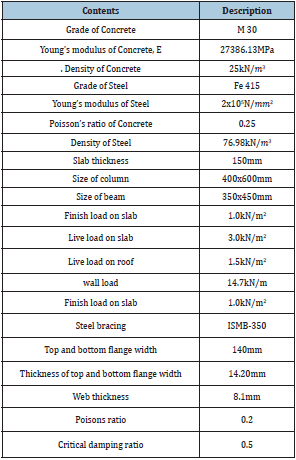
Table 2: BRB properties and its sectional dimension.
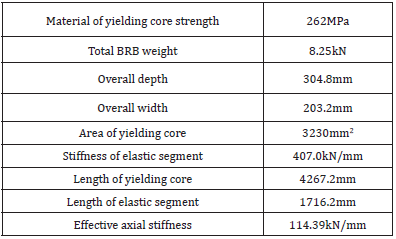
a) Model No.1: Bare frame building is symmetrical in plan with
bracing system as shown in (Figure 1a). However, mass of
building is included.
b) Model No.2: Bare frame building is symmetrical in plan
with bracing system as shown in (Figure 1b). The Vertical
configuration of a structure and lateral force resisting system
in top story consist an offset of 40% in X direction on each side.
c) Model No.3: Bare frame building is symmetrical in plan
with bracing system as shown in (Figure 1c). The Vertical
configuration of a structure and lateral force resisting system
in top story consist an offset of 20% in X direction on each side.
d) Model No.4: Bare frame building is symmetrical in plan with
bracing system and with horizontal re-entrant irregularity in
the form of L-Shaped as shown in (Figure 1d).
e) Model No.5: Bare frame building is symmetrical in plan with
bracing system and with Horizontal irregularity consisting of
plus (+) shaped building as shown in (Figure 1e).
Figure 1(a-e): Plan and Elevation view of Models.
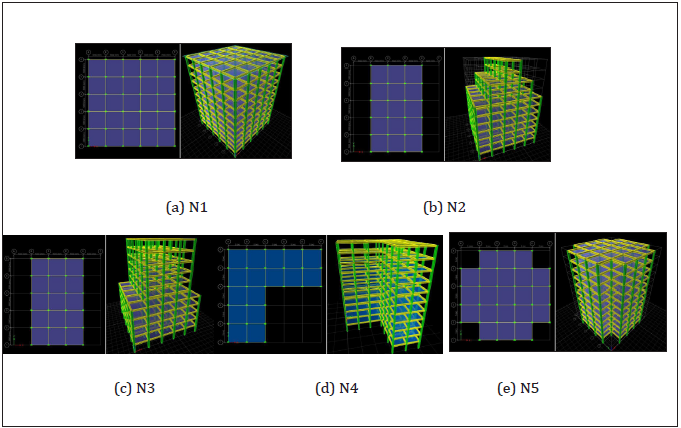
To all these models’ different types of bracing are employed such as V-type steel bracing and buckling restrained bracing and their results are subsequently compared with the bare frame models. Steel bracing are provided alternately on the outer periphery of the building and these model naming Model N-1, 2, 3, 4, 5 various types of steel bracing are employed, and the results of each models are compared with its subsequent bare frame model and the results of each models are compared with its subsequent bare frame model. The comparison is done between the Pushover curve, Performance point and the formation of hinges in the whole building, this hinge formation tells. The cross-section plan of building is 25x25m. Each storey height of the building is 3.2m with total height is equal to 35.2m. Models with two different types of bracing has been shown in the (Figure 2a,2b) respectively.
Figure 2(a,b): Model with steel V bracing and buckling restrained bracing.
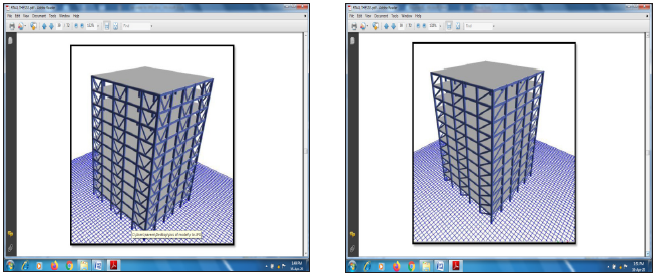
Result and Discussion
All the building models considered for the study with different irregular configuration in geometry are presented and their results are compared by doing Non-Linear Static Pushover Analysis using ETABS software. The results are focuses on pushover curve, performance point and the Performance Based Seismic Design of the building. Pushover analysis is done until the collapse mechanism reaches.
Pushover curve
The graphical representation between base shear and displacement and Pushover Curve results are shown in (Figure 3ae) and in (Table 3) respectively. The Pushover curve of Model N1.N2. N3.N4 and N5 in which comparing the Pushover curve for the Bare Frame, V Bracing and the Buckling Restrained braced model. It can be seen from these figures the design base shear and the capacity value are much higher than the design value. Further it is observed that the bare frame shows more performance displacement and less performance base shear capacity as compared to other two models with different bracings. The introduction of bracing to these models has increased the performance level both in terms of Base shear carrying capacity as well as roof displacement. It is found that by using V-Bracing to the model No.1 gives better results as compared to BRB bracing. The reduction in displacement and Base shear is found to be more by using V type steel bracing as compared to BRB. The maximum displacement for bare frame comes out to be around 291.3mm, for V-Brace frame it is around 88mm and for BRB bracing it is around 120mm. So, it can be seen that there is a huge decrease in the displacement value by using V-Braced steel bracing. BRB is also found out to be effective in reducing displacement. The maximum Base shear for Bare frame is found out to be around 13234.3KN, for V-Braced frame it is around 14200kN and for BRB frame it is around 14000kN. It has been seen from the Pushover curve that the introduction of bracing to these models has increased the performance level both in terms of Base shear carrying capacity as well as roof displacement and seen that the Base shear carrying capacity of the building also increases by using V-braced and BRB bracings.
Table 3: Pushover curve results.
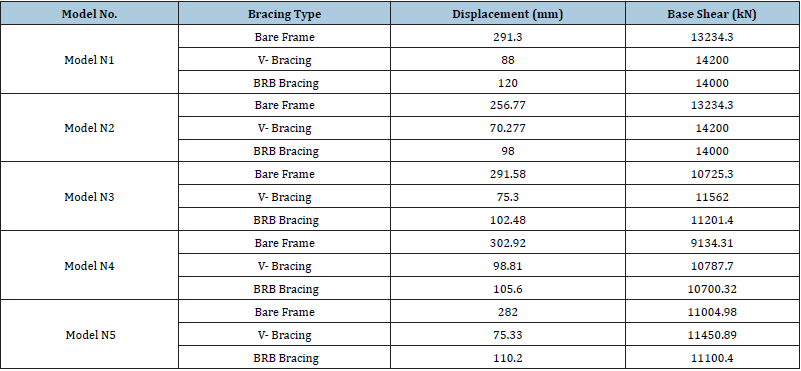
Hinges formation results
The (Figure 3a-c) shows the typical formation of hinges in a 3D model of the building for the Bare frame, V Braced Frame and Buckling Restrained Bracing. Various Non-Linear hinges are formed by doing Pushover analysis and their results are compared to the models with different types of bracings. It is seen in figure that the formation of hinges is very large in bare frame model as compared to other models. But most of these hinges are in the range of immediate occupancy, which means less damage will occur during this earthquake. Further the formation of hinges for V-Braced frame and the BRB frame are found to be very less in immediate occupancy level and few in Life safety level.
Figure 3(a-e): Comparison of Pushover curve for Model N1.2.3.4.5.
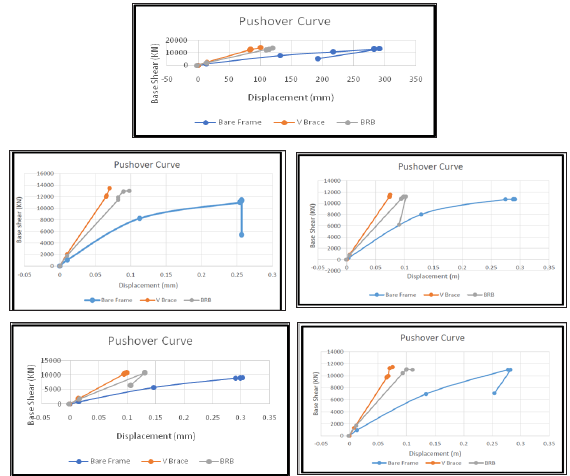
Performance point
The Performance point is the intersection of the demand and capacity curves are shown in (Figure 4a-c) and the results are tabulated in (Table 4). During pushover analysis if a building is having performance point and the damage at the same point is acceptable then the structure is said to be satisfying the target performance level. From the graphs of Model no.1 with Bare, V-Braced and BRB braced frame it is found that the addition of V-Bracing increases the performance point of the building which means it increases the performance level of the building. It is found to be minimum for bare frame i.e., 2786.83kN, maximum for V-Braced building i.e., 3007.27kN and intermediate for BRB braced building i.e., 2973.22kN. The performance point of model no.1 of Bare Frame, V Brace and BRB are presented here.
Table 4: Performance based results.
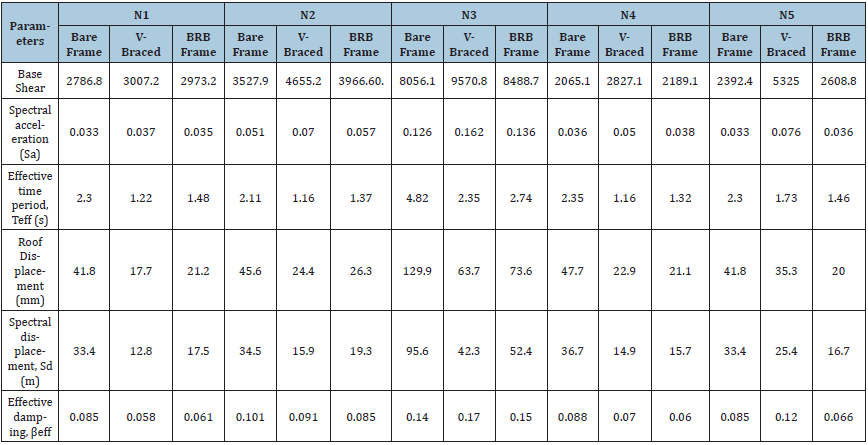
Figure 4(a-c): Hinge formation in 3D, bare frame -braced and BRB Frame.

Conclusion
Based on the work conducted following conclusions can be drawn. The bare frame models show lower strength and stiffness values as compared to models with steel and buckling restrained bracing. As the shape of the triangular load pattern and first mode shape are similar for mid-rise regular buildings and close for highrise and set back buildings, the resulting pushover curves are found to be similar for almost all the building studied here. It is found that the displacement values for all the bare frame models gets very large as compared to the buildings with providing bracings. Provision of bracing is quite effective in controlling the lateral forces. The Base shear was found to more for all the models that uses the bracings, instead of only Model no.4 which shows very less variation in base shear of all three models viz. bare Frame, V-brace and BRB frame. Effect of providing buckling restrained bracing gives quite good results by lowering the displacement values and by increasing the base shear values as compared to bare frame models. The Pushover curve base shear for all the models was found higher values than the design base shear, which show such building can resist earthquake forces safely. Most of the hinges formed was also in the range of immediate occupancy and few hinges are formed under life safety and collapse prevention level. It is also seen that these hinges formation in building will not collapse for this level of earthquake. It was found that the formation of hinges was more for all the cases of bare frame models, which gets reduced by applying the steel bracings and BRB bracings.
References
- Sahoo DR, Chao SH (2010) Performance based plastic design method for buckling-restrained braced frames. Engineering Structures 32(9): 2950-2958.
- Mohammed N, Nazrul I (2013) Pushover analysis of medium rise multi-story RCC frame with and without vertical irregularity. International Journal of Innovative Research in Science Engineering and Technology 3(5): 540-546.
- Prasad V, Philip N (2014) Seismic analysis of RC building with steel bracing. International Journal of Engineering Research & Technology 2(5): 1-10.
- Baikerikar A, Kanagali K (2014) Pushover analysis of RC frame structures: A case study. International Journal of Advanced Technology in Engineering and Science 2(10): 1-9.
- Karthik KM, Vidyashree (2015) Effect of steel bracing on vertically irregular RCC building frames under seismic loads. International Journal of Research in Engineering and Technology 4(6): 90-96.
- Neha P, Modakwar (2015) Seismic analysis of structures with irregularities. IOSR Journal of Mechanical and Civil Engineering 2278-1684: 63-66.
- Kulkarni S, Yogeendra RHG (2015) Seismic evaluation and comparisons of plan irregular and plan irregular soft storey building with cross bracing and shear wall system. International Journal of Engineering Research & Science 1(5): 48-54.
- Nikhil D, Sontakke P, Lande S (2016) Comparative study of buckling restrained braces and conventional braces in a medium rise building. International Journal of Engineering 5(3): 625-628.
- Eghbali M, E Asadian, Amiri GG, Amrei SAR (2017) Seismic performance of steel frames equipped with buckling-restrained braces (BRBs) using nonlinear static and dynamic analyses. JVO International ltd 19(2): 1131-1146.
- (2000) FEMA 356 Pre-standard and commentary for the seismic rehabilitation of buildings. Federal Emergency Management Agency, Washington DC, USA.
© 2021 Naveen Kumar. This is an open access article distributed under the terms of the Creative Commons Attribution License , which permits unrestricted use, distribution, and build upon your work non-commercially.
 a Creative Commons Attribution 4.0 International License. Based on a work at www.crimsonpublishers.com.
Best viewed in
a Creative Commons Attribution 4.0 International License. Based on a work at www.crimsonpublishers.com.
Best viewed in 







.jpg)






























 Editorial Board Registrations
Editorial Board Registrations Submit your Article
Submit your Article Refer a Friend
Refer a Friend Advertise With Us
Advertise With Us
.jpg)






.jpg)














.bmp)
.jpg)
.png)
.jpg)










.jpg)






.png)

.png)



.png)






